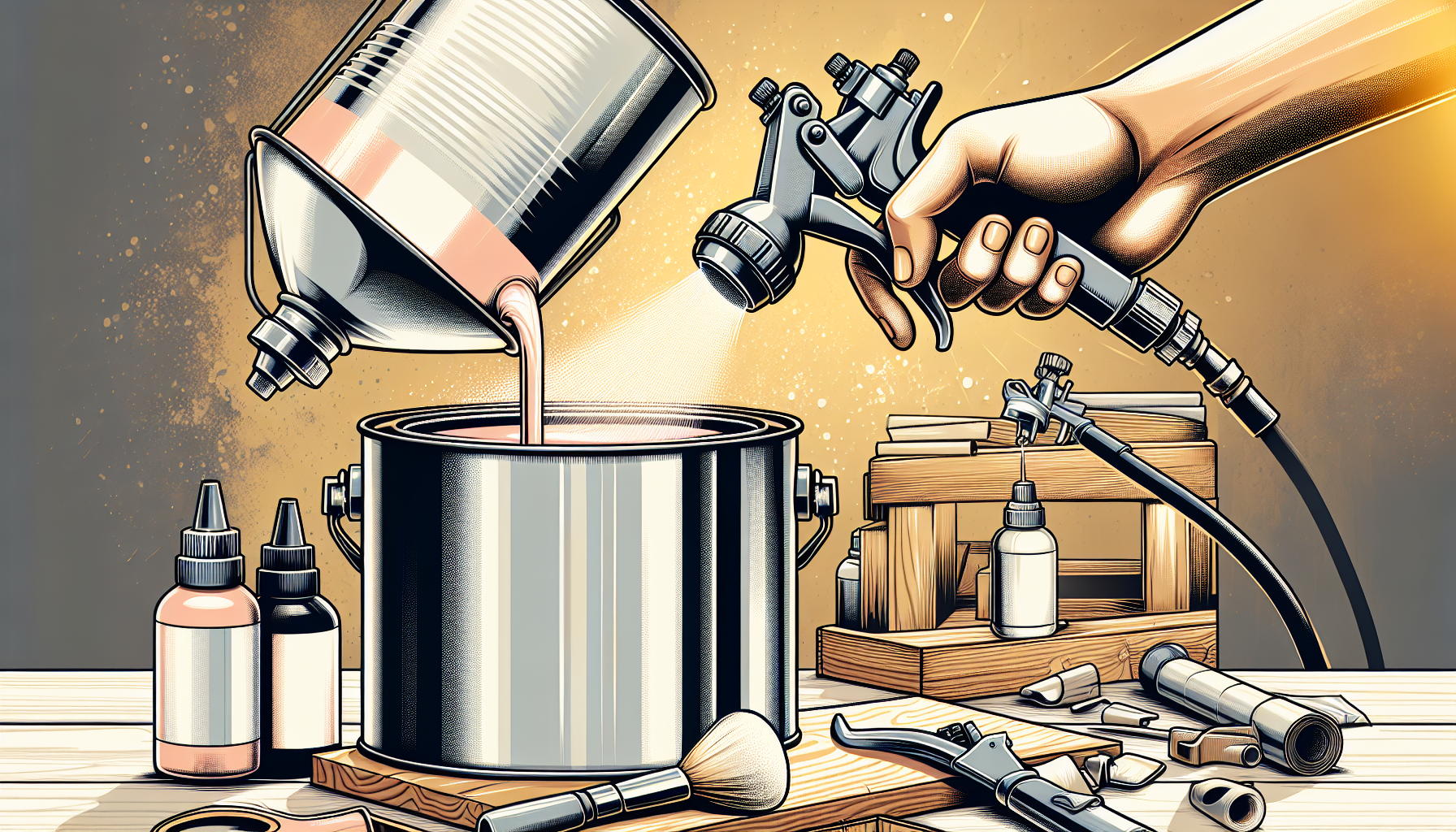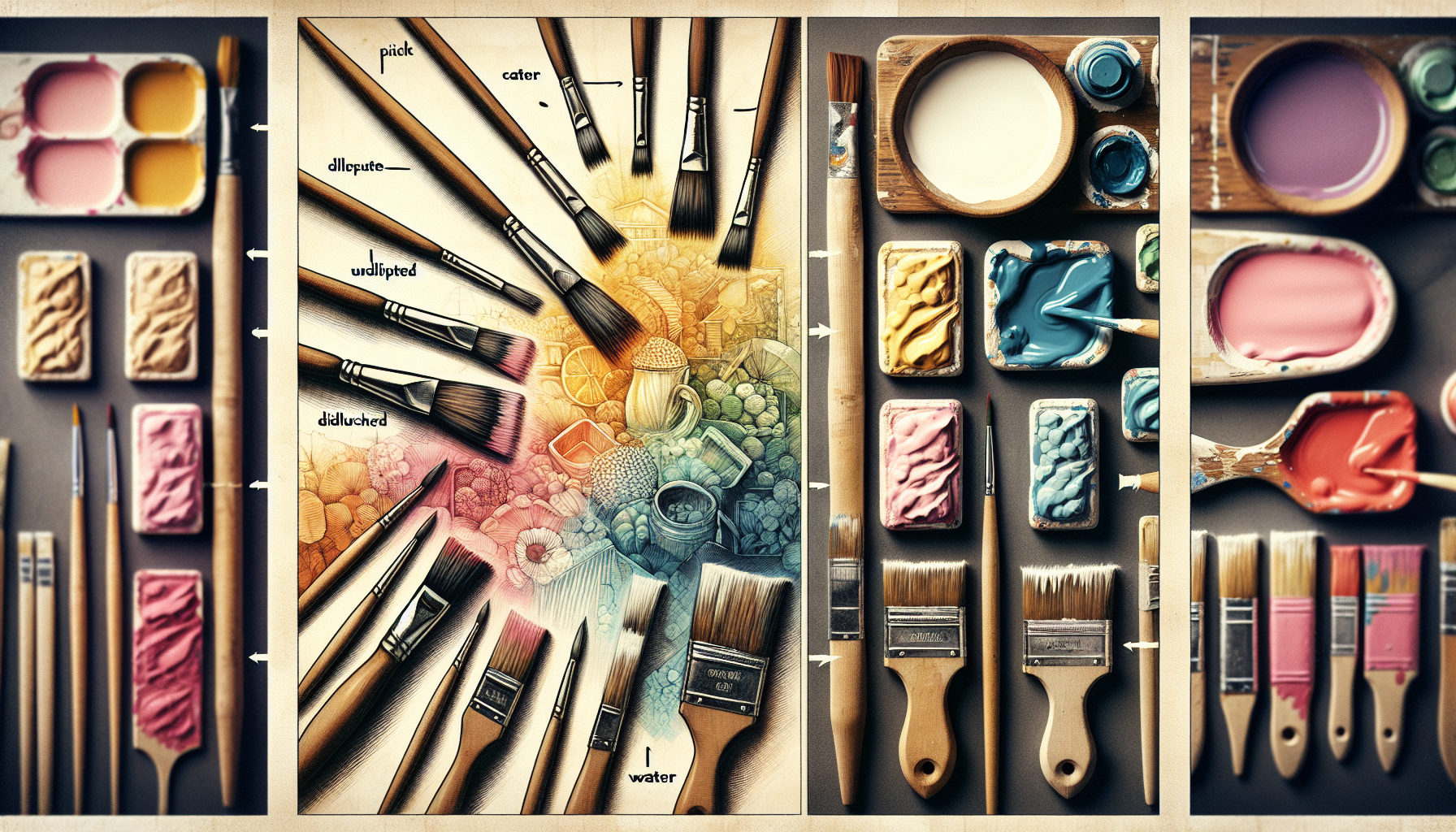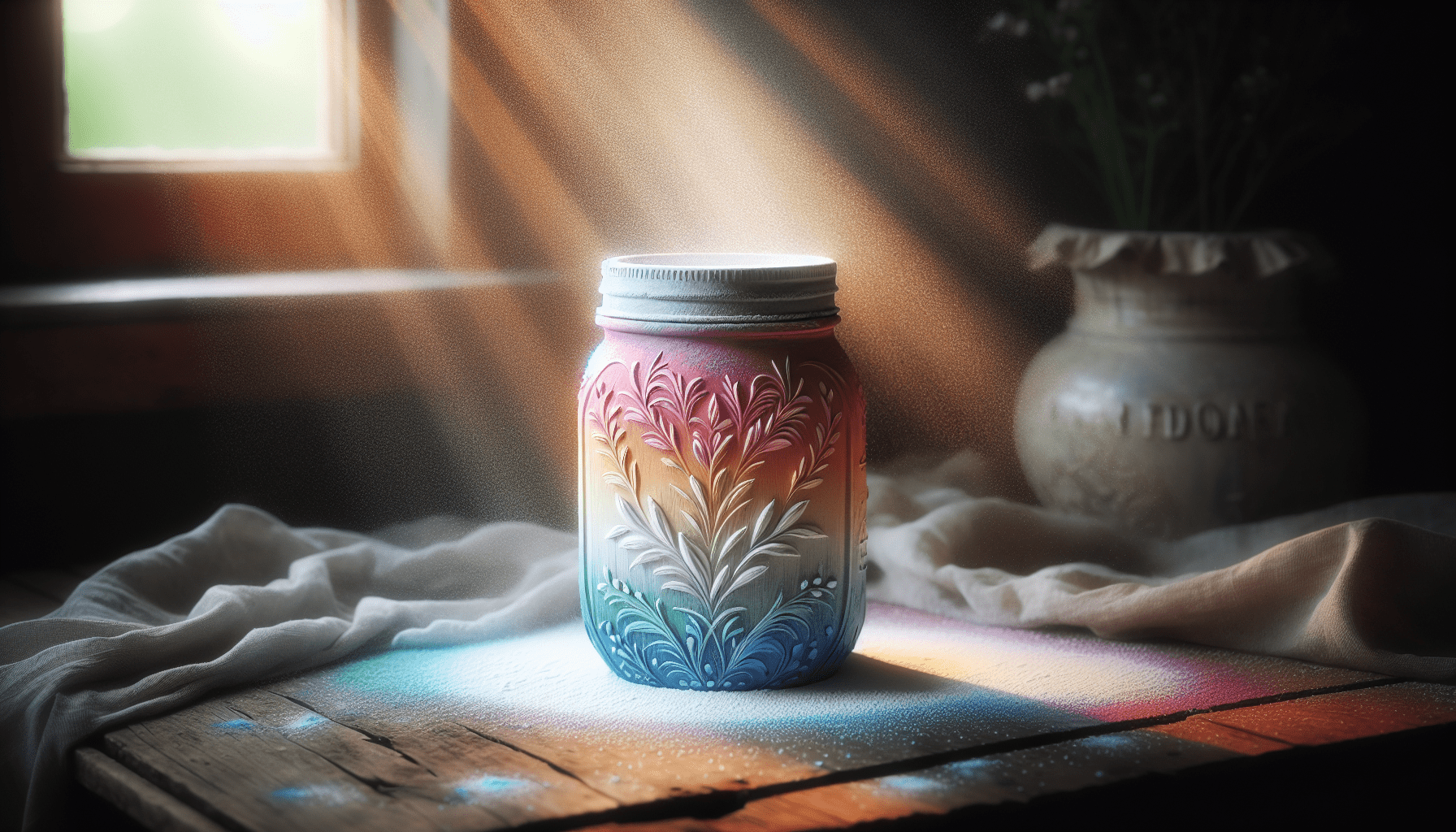In this article, you will learn the key steps and techniques for effectively thinning chalk paint for sprayer application. Whether you are a professional painter or a DIY enthusiast, understanding how to properly thin chalk paint can make a significant difference in achieving a smooth and flawless finish. By following the guidelines provided, you will be able to confidently thin chalk paint to the ideal consistency for your sprayer, ensuring optimal coverage and professional-looking results.
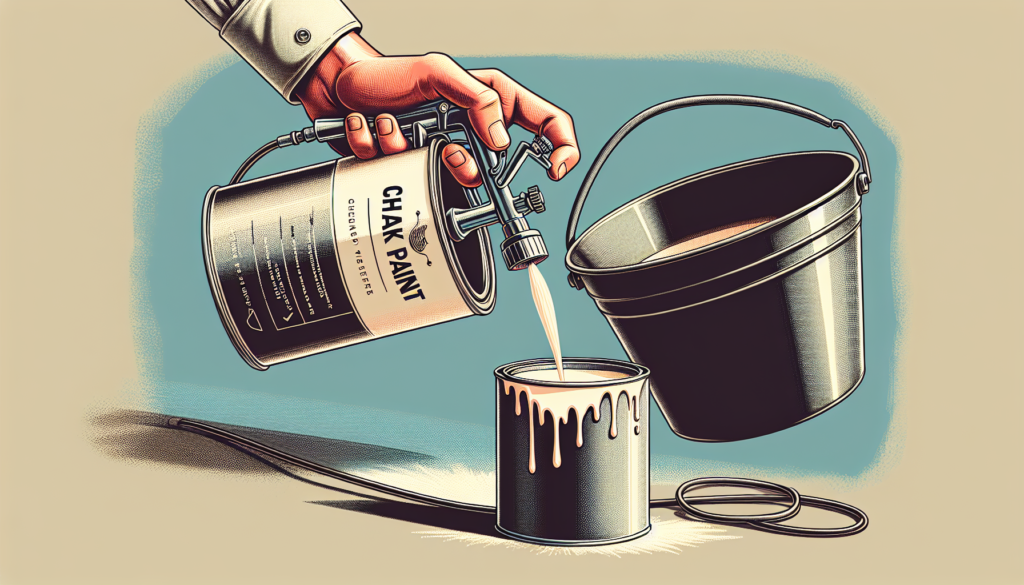
What is Chalk Paint
Chalk paint is a type of paint that has gained popularity in recent years for its versatility and unique finish. It is a decorative paint that can be used on a variety of surfaces, including wood, metal, and even fabric. The name “chalk paint” comes from the soft, matte finish it leaves on surfaces, resembling the look of a chalkboard. Chalk paint is known for its easy application and ability to adhere to surfaces without the need for extensive preparation or priming.
Definition
Chalk paint is a water-based paint that contains chalk or calcium carbonate as one of its main ingredients. This gives the paint its characteristic matte finish and allows it to be easily distressed for a vintage or aged look. Chalk paint is often chosen for its ability to create a smooth and even coverage, even on uneven or textured surfaces. It is also known for its quick drying time, making it a popular choice for furniture and home decor projects.
Benefits of Using Chalk Paint
There are several benefits to using chalk paint, especially when it comes to spraying.
Firstly, chalk paint has a high pigment concentration, which means that it provides excellent coverage with minimal coats. This is particularly advantageous when using a paint sprayer, as it allows for efficient and even application over larger surfaces.
Secondly, chalk paint has a quick drying time, which reduces the risk of streaks or drips when spraying. This allows for a smoother finish and saves time during the painting process.
Another benefit of using chalk paint for spraying is its ease of use. Chalk paint does not require extensive surface preparation, such as sanding or priming, which is often necessary with other types of paint. This makes it a convenient option for those looking for a quick and hassle-free painting experience.
Furthermore, chalk paint is known for its durability and resistance to chipping or peeling. Once applied and properly sealed, chalk paint can withstand everyday wear and tear, making it suitable for both indoor and outdoor projects.
Lastly, chalk paint offers a wide range of colors and finishes to choose from. Whether you prefer bold and vibrant hues or subtle and muted tones, there is a chalk paint color to suit every taste and style.
Overall, the benefits of using chalk paint for spraying make it an excellent choice for DIY enthusiasts, professional painters, and anyone looking to transform their furniture or home decor with ease and precision.
Choosing the Right Chalk Paint for Sprayer
When it comes to choosing the right chalk paint for spraying, there are a few factors to consider.
Water-Based vs. Oil-Based Chalk Paint
The first decision to make is whether to use water-based or oil-based chalk paint. Water-based chalk paint is generally recommended for spraying, as it is easier to clean up and has a quicker drying time compared to oil-based chalk paint. Additionally, water-based chalk paint tends to have a lower odor, which can be an important consideration when working in enclosed spaces.
Considerations for Spraying Chalk Paint
When selecting a chalk paint specifically for spraying, it is important to check the manufacturer’s guidelines and ensure that the paint is suitable for spraying application. Some chalk paints may require thinning or have specific recommendations for spraying, so it is crucial to follow these guidelines to achieve the best results.
Recommended Chalk Paint Brands for Spraying
There are several reputable chalk paint brands that are known for their suitability for spraying. Some popular brands include Annie Sloan Chalk Paint, Rust-Oleum Chalked Paint, and DecoArt Americana Decor Chalky Finish Paint. These brands offer a wide range of colors and finishes and are often recommended by professionals for their ease of use and quality results when sprayed.
When choosing a chalk paint for spraying, it is essential to select a high-quality brand that provides good coverage, adheres well to surfaces, and offers excellent durability once sealed.
Preparing the Paint Sprayer
Before starting to spray chalk paint, it is crucial to properly prepare the paint sprayer for optimal performance and results. Here are the steps to follow:
Clean the Sprayer
Start by thoroughly cleaning the paint sprayer. Remove any remaining paint or residue from previous use and ensure that all parts are clean and free from clogs or blockages. This will help prevent any unwanted particles or debris from affecting the paint application.
Choose the Right Spray Tip
Selecting the correct spray tip for your paint sprayer is essential for achieving the desired finish and coverage. Different spray tips produce different spray patterns and control the flow of paint. Consult the manufacturer’s instructions or the paint sprayer’s manual to determine the appropriate spray tip size for the type of chalk paint you are using.
Set the Sprayer Flow and Pressure
Adjust the flow and pressure settings on the paint sprayer according to the manufacturer’s instructions. This will ensure that the chalk paint is sprayed evenly and smoothly without any sputtering or overspray. It is important to find the right balance between flow and pressure to achieve the desired coverage and finish.
Use Appropriate Protective Equipment
When using a paint sprayer, it is essential to wear appropriate protective equipment to ensure personal safety. This includes safety goggles or a face shield to protect the eyes, a respirator or mask to prevent inhaling paint particles, and gloves to protect the hands from direct contact with the paint or any cleaning agents used.
By properly preparing the paint sprayer, you can ensure that it operates smoothly and efficiently, allowing for consistent and professional-looking results when spraying chalk paint.
Preparing Chalk Paint for Spraying
To achieve the best results when spraying chalk paint, it is important to properly prepare the paint before loading it into the sprayer. Follow these steps to prepare chalk paint for spraying:
Read the Manufacturer’s Instructions
Start by carefully reading and familiarizing yourself with the manufacturer’s instructions for the specific type and brand of chalk paint you are using. These instructions will often provide guidance on thinning the paint for spraying, as well as any other specific considerations or recommendations.
Check the Consistency of the Chalk Paint
Before thinning the chalk paint, check its consistency straight from the container. Chalk paint should have a smooth and easy-flowing consistency that allows for seamless spraying. If the paint appears too thick or gloopy, it may need to be thinned down to achieve optimal spraying results.
Choose the Thinning Agent
Selecting the appropriate thinning agent for chalk paint is crucial for achieving the desired consistency and flow. The choice of thinning agent will largely depend on the type of chalk paint you are using and any specific recommendations provided by the manufacturer. Common thinning agents for chalk paint include water, Floetrol, and paint thinner.
Measure and Mix the Thinning Agent
Carefully measure the recommended amount of thinning agent based on the manufacturer’s instructions or general guidelines for the specific thinning agent you are using. Add the thinning agent to the chalk paint gradually, mixing well after each addition. Be cautious not to add too much thinning agent, as this can result in over-thinning the paint and affecting its adhesion and coverage.
Test the Thinned Chalk Paint
Once the chalk paint and thinning agent are thoroughly mixed, it is important to test its consistency before loading it into the paint sprayer. Apply a small amount of the thinned paint onto a scrap piece of material or cardboard to determine if the consistency is suitable for spraying. The paint should flow smoothly and evenly without any clogs or splatters.
By properly preparing the chalk paint for spraying, you can ensure that it is at the optimal consistency and will provide a seamless and professional finish on your desired surface.
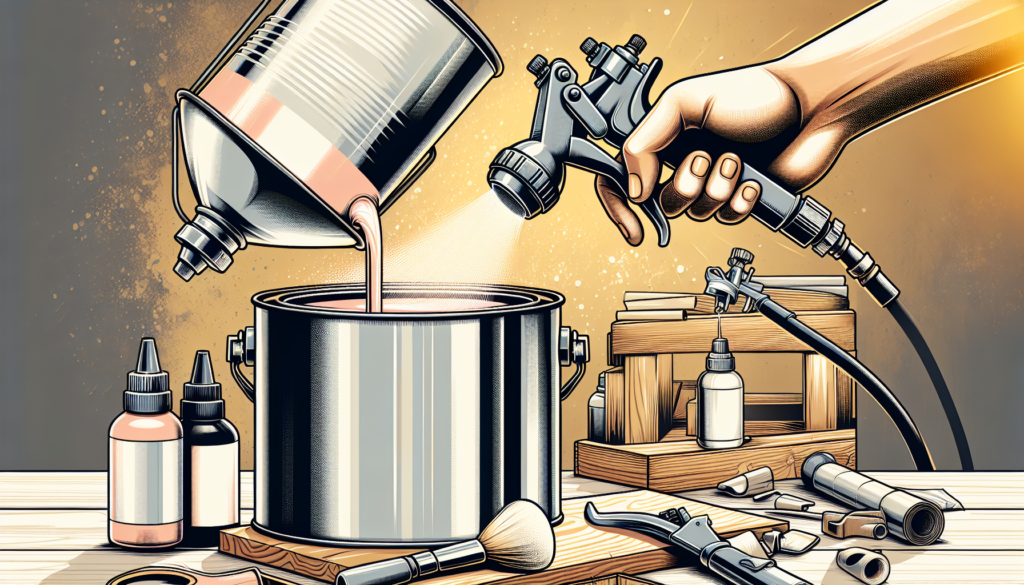
Methods to Thin Chalk Paint
When it comes to thinning chalk paint for spraying, there are several methods that can be used to achieve the desired consistency. The choice of method will largely depend on personal preference, the type of chalk paint being used, and the desired final result. Here are three common methods for thinning chalk paint:
Adding Water
Water is a readily available and cost-effective thinning agent for chalk paint. It is suitable for water-based chalk paint and can help adjust the consistency to achieve smoother spraying. When adding water to chalk paint, it is important to do so gradually and test the consistency after each addition to avoid over-thinning.
Using Floetrol
Floetrol is a popular thinning agent commonly used with water-based paints, including chalk paint. It is an additive that helps improve the flow and leveling properties of paint, resulting in a smoother and more even finish. When using Floetrol to thin chalk paint, carefully measure and follow the manufacturer’s instructions to achieve the desired consistency.
Using Paint Thinner
For oil-based chalk paint, paint thinner is often the preferred choice for thinning. It helps reduce the thickness of the paint and ensures smoother spraying. When using paint thinner, it is crucial to follow the manufacturer’s instructions or general guidelines for the specific type of paint thinner being used. Careful measurement and gradual addition are key to achieving the desired consistency without over-thinning the paint.
By using any of these methods to thin chalk paint, you can adjust the consistency to suit your specific spraying needs and achieve a professional and flawless finish.
Thinning Chalk Paint with Water
When it comes to thinning chalk paint with water, there are a few steps to follow to achieve the desired consistency and flow. Here is a guide to thinning chalk paint with water:
Test the Thickness of the Chalk Paint
Before adding water, evaluate the thickness of the chalk paint straight from the container. The paint should have a smooth and easy-flowing consistency. If it appears too thick or gloopy, it may need to be thinned down with water.
Add Distilled Water in Small Increments
Gradually add distilled water to the chalk paint in small increments, mixing well after each addition. It is crucial to add water slowly and test the consistency after each addition to avoid over-thinning the paint. Aim for a smooth and pourable consistency that allows for seamless spraying.
Mix Thoroughly and Test the Consistency
After adding water, thoroughly mix the chalk paint to ensure the water is evenly distributed. Test the consistency by spraying a small amount of the thinned paint onto a scrap piece of material or cardboard. The paint should flow smoothly and evenly without any clogs or splatters. If the consistency is not suitable, make further adjustments by adding more water or the desired thinning agent.
By following these steps, you can effectively thin chalk paint with water to achieve the desired consistency for spraying.
Thinning Chalk Paint with Floetrol
Thinning chalk paint with Floetrol can help improve the flow and leveling properties of the paint, resulting in a smoother and more even finish. Here is a step-by-step guide to thinning chalk paint with Floetrol:
Understand the Purpose of Floetrol
Before using Floetrol, it is important to understand its purpose and how it affects the paint. Floetrol is an additive that helps to prolong the drying time of paint, allowing it to level and flow better. It can also help reduce brush and roller marks, making it a valuable tool when spraying chalk paint.
Measure the Amount of Floetrol
Follow the manufacturer’s instructions to accurately measure the amount of Floetrol needed to thin the chalk paint. The recommended ratio of Floetrol to chalk paint will vary depending on factors such as the brand of Floetrol and the desired consistency. It is important to measure the Floetrol accurately to achieve consistent results.
Slowly Add Floetrol to Chalk Paint
Gradually add the measured amount of Floetrol to the chalk paint, mixing well after each addition. It is essential to add Floetrol slowly to avoid over-thinning the paint. As Floetrol is a thick liquid, it is best to pour it in small increments while continuously stirring the paint. This will ensure that the Floetrol is evenly incorporated and properly thins the chalk paint.
Mix the Paint Mixture and Test Consistency
Thoroughly mix the chalk paint and Floetrol to ensure the additive is evenly distributed. Test the consistency by spraying a small amount of the thinned paint onto a scrap piece of material or cardboard. The paint should flow smoothly and evenly without any clogs or splatters. If the consistency is not ideal, make adjustments by adding more Floetrol or the chosen thinning agent.
By following these steps, you can effectively thin chalk paint with Floetrol and achieve a smoother and more professional finish when spraying.
Thinning Chalk Paint with Paint Thinner
For oil-based chalk paint, paint thinner is often the preferred choice for thinning. Here is a guide to thinning chalk paint with paint thinner:
Considerations when Using Paint Thinner
When using paint thinner to thin chalk paint, it is important to take certain considerations into account. Paint thinners can have strong fumes and should only be used in well-ventilated areas. It is also crucial to follow the manufacturer’s instructions and safety guidelines when handling and using paint thinner.
Measure the Paint Thinner
Carefully measure the recommended amount of paint thinner for thinning chalk paint. The exact ratio will vary depending on factors such as the specific type of chalk paint and the desired consistency. Accurate measurement is vital to achieve consistent results and prevent over-thinning the paint.
Slowly Add Paint Thinner to the Chalk Paint
Gradually add the measured paint thinner to the chalk paint, mixing well after each addition. It is important to add paint thinner slowly to avoid over-thinning the paint. As paint thinner can be a strong solvent, it is best to pour it in small increments while continuously stirring the paint. This will ensure that the paint thinner is evenly incorporated and properly thins the chalk paint.
Mix Thoroughly and Test the Paint Consistency
Thoroughly mix the chalk paint and paint thinner to ensure that the thinner is evenly distributed. Test the consistency by spraying a small amount of the thinned paint onto a scrap piece of material or cardboard. The paint should flow smoothly and evenly without any clogs or splatters. If the consistency is not suitable, make further adjustments by adding more paint thinner or the desired thinning agent.
When using paint thinner to thin chalk paint, it is crucial to follow safety guidelines and properly ventilate the workspace. Additionally, avoid using too much paint thinner, as this can negatively affect the adhesion and coverage of the chalk paint.
Common Mistakes when Thinning Chalk Paint
Thinning chalk paint for spraying requires careful consideration and attention to detail. Here are some common mistakes to avoid when thinning chalk paint:
Over-Thinning the Paint
Adding too much thinning agent, whether it be water, Floetrol, or paint thinner, can result in over-thinning the chalk paint. Over-thinning can lead to poor adhesion, uneven coverage, and a lack of vibrancy in color. It is important to follow the recommended ratios and guidelines provided by the manufacturer to achieve the desired consistency without compromising the paint’s integrity.
Under-Thinning the Paint
On the other hand, under-thinning the chalk paint can result in a thicker consistency that is unsuitable for spraying. This can lead to clogs and splatters, resulting in an uneven and unprofessional finish. It is crucial to gradually add thinning agents and test the consistency periodically to avoid under-thinning the paint.
Not Testing the Consistency Properly
Properly testing the paint’s consistency before loading it into the sprayer is crucial for achieving successful results. By spraying a small amount of the thinned paint onto a scrap piece of material or cardboard, you can evaluate the flow, coverage, and overall performance of the paint. Failure to test the consistency can result in unforeseen issues during spraying, leading to inconsistencies and unsatisfactory results.
By being aware of these common mistakes and taking the necessary precautions, you can avoid potential pitfalls and achieve the optimal consistency for spraying chalk paint.
Tips for Spraying Chalk Paint
Once you have properly thinned the chalk paint and prepared the sprayer, it is time to start spraying. Here are some tips to ensure the best results when spraying chalk paint:
Practice on Scrap Material
Before tackling your main project, it is advisable to practice spraying on a scrap piece of material or cardboard. This will allow you to adjust the flow, pressure, and technique before moving on to the actual surface. Practicing helps familiarize yourself with the sprayer and ensures smoother and more consistent results.
Move with Consistent Speed and Pressure
When spraying chalk paint, it is important to maintain a consistent speed and pressure throughout the application. Moving too quickly can result in thin and uneven coverage, while moving too slowly can lead to drips and runs. Finding a comfortable and steady rhythm will help achieve an even and professional finish.
Apply Multiple Thin Coats
To achieve optimal coverage and a smooth finish, it is recommended to apply multiple thin coats of chalk paint rather than one heavy coat. This allows each layer to dry properly and minimizes the risk of drips or streaks. Applying multiple thin coats also allows for better control and ensures that the paint adheres well to the surface.
Clean the Sprayer After Use
After completing your spraying project, it is crucial to thoroughly clean the paint sprayer according to the manufacturer’s instructions. Failing to clean the sprayer can result in clogs and blockages, affecting its performance in future projects. Proper maintenance and cleaning of the sprayer will prolong its lifespan and ensure optimal spraying results.
Store the Thinned Chalk Paint Properly
If you have any leftover thinned chalk paint, it is important to store it properly to maintain its quality. Seal the container tightly and keep it in a cool and dry place away from direct sunlight. This will help prevent the paint from drying out or deteriorating, allowing you to reuse it for future projects.
By following these tips, you can achieve professional-looking results when spraying chalk paint and ensure a smooth and efficient painting process.
In conclusion, thinning chalk paint for spraying requires careful consideration and adherence to specific guidelines. By selecting the right chalk paint, properly preparing the sprayer, and following the recommended methods for thinning, you can achieve a flawless and professional finish on a variety of surfaces. Practice, patience, and attention to detail are key when spraying chalk paint, and by implementing the tips and techniques outlined in this article, you can successfully transform your furniture and home decor projects with ease.
